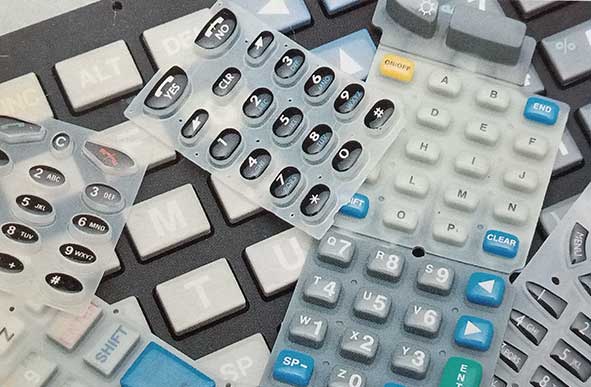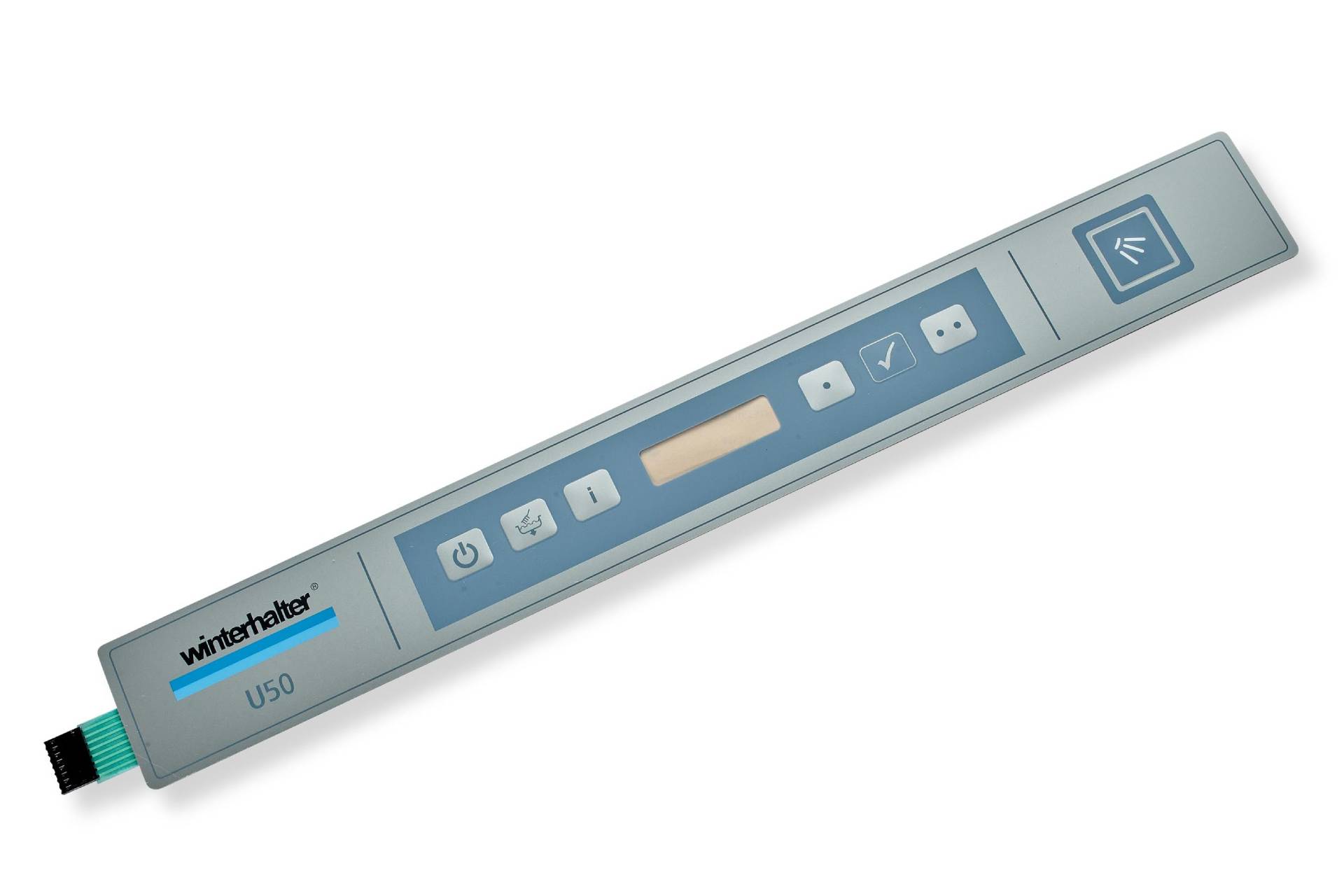A Comprehensive Guide to the Production and Handling of Rubber Keypads for Ideal Efficiency
The production and processing of rubber keypads play a necessary function in their performance and use. Material option, design precision, and innovative production methods substantially influence their durability and performance. Understanding these elements is essential for producing high-grade products. As various developments emerge in this field, exploring their effects could disclose new requirements for functionality and individual experience. What essential aspects will form the future of rubber keypads?
Recognizing Rubber Keypads: Products and Types
Rubber keypads are vital elements in many tools, using an equilibrium of resilience and tactile responses. These keypads are mostly made from silicone or synthetic rubber, materials picked for their flexibility and resilience. Silicone rubber, specifically, is favored for its excellent temperature resistance and long life, making it suitable for different applications, from consumer electronic devices to commercial equipment.
There are numerous sorts of rubber keypads, including dome button keypads, which make use of a dome-shaped device that gives responsive comments when pressed. Additionally, there are also flat keypads, which feature a smooth surface and are typically used in push-button controls and medical gadgets. The option of product and type affects the keypad's efficiency, feel, and general customer experience. Understanding these facets is essential for suppliers and designers aiming to produce trustworthy and efficient interfaces in their products.
The Production Refine: From Style to Manufacturing
The manufacturing process of rubber keypads entails a number of crucial stages, starting with design and ending with manufacturing. Initially, designers produce detailed specifications and models, guaranteeing the keypad meets useful and visual demands. Computer-aided design (CAD) software application is commonly used to visualize the format and functions prior to proceeding.
As soon as the style is settled, material selection is essential, with alternatives usually including silicone or all-natural rubber. In the following stage, molds are developed based on the approved layouts, which will shape the keypads during production.
Adhering to mold production, the manufacturing phase starts, where rubber is blended with ingredients to improve performance. The mixture is after that poured into molds and based on warm and stress, permitting it to cure and solidify.
The completed keypads undergo top quality checks to confirm they satisfy established criteria, followed by packaging for distribution. This all-encompassing process assurances peak efficiency in the last item.
Trick Strategies in Rubber Molding
In the domain name of rubber keypads, numerous molding methods play a pivotal function in determining the high quality and functionality of the last item. One widespread method is compression molding, where raw rubber is positioned in a heated mold and pressure is used, enabling efficient automation and harmony. One more considerable technique is shot molding, which entails injecting heated rubber into a mold, supplying better precision and complex shapes. Transfer molding, a crossbreed of both approaches, is likewise used, specifically for detailed layouts, as it integrates the benefits of both processes. Furthermore, fluid silicone rubber (LSR) molding is getting grip because of its flexibility and durability, making it suitable for high-performance applications. Each strategy has one-of-a-kind features, influencing factors such as cycle time, material waste, and manufacturing prices. Selecting the proper molding technique is important for attaining peak efficiency in rubber keypads.
Surface Area Finishing and Texturing Options
Surface area ending up and texturing alternatives play an essential function in enhancing the tactile experience and visual appeal of rubber keypads. Producers use numerous methods to create distinctive surface characteristics that impact customer communication and product style. Typical finishing techniques include matte, shiny, and satin surfaces, each offering various visual effects and grasp levels. Texturing alternatives, such as increased patterns, grooves, or stippling, better enhance capability by improving grip and decreasing slippage during use.
Furthermore, certain structures can be customized to meet ergonomic requirements, offering convenience during prolonged usage. The option of surface area coatings and textures can be affected by the designated application of the keypad, whether it be for consumer electronics, automotive controls, or industrial gadgets. Eventually, cautious consideration of these choices contributes considerably to user satisfaction and general item efficiency, making them vital elements in the layout and manufacturing procedure of rubber keypads.
High Quality Control Procedures in Rubber Keypad Production
Quality assurance measures in rubber keypad manufacturing are crucial for guaranteeing item integrity and performance. These actions incorporate material choice criteria, rigorous testing treatments, and strict final assessment criteria. With each other, they develop a comprehensive framework that assists manufacturers maintain quality throughout the production procedure.

Product Choice Requirements
Selecting the suitable materials for rubber keypads is essential, as it directly influences their customer, sturdiness, and functionality experience. Trick requirements for material selection include tensile strength, strength, and environmental resistance. The option of rubber substance, such as silicone or polycarbonate elastomer article source (TPE), plays an essential duty in achieving desired tactile responses and long life. Additionally, aspects like chemical compatibility, temperature stability, and UV resistance have to be taken into consideration to ensure maximum performance in various applications. Manufacturers must additionally review the convenience of processing and cost-effectiveness of materials, balancing top quality with budget restrictions. Eventually, the appropriate product option not only improves the keypad's performance but also adds to general product top quality and consumer satisfaction.
Checking Treatments Executed
After establishing the proper materials for rubber keypads, extensive screening treatments are applied to validate that the end products satisfy sector standards and client assumptions. These procedures usually include mechanical screening, which assesses the sturdiness and flexibility of the rubber under numerous problems. Furthermore, ecological screening examines the keypads' performance under temperature level changes, moisture, and direct exposure to chemicals. Electric testing confirms the keypads operate correctly with electronic parts, validating responsiveness and conductivity. Responsive comments is evaluated to assure user fulfillment. These considerable testing actions are essential in recognizing any kind of incongruities or defects prior to mass manufacturing, inevitably improving the reliability and performance of rubber keypads in their desired applications.

Final Evaluation Criteria
Thorough last examination requirements are vital in rubber keypad manufacturing to ensure that each system satisfies the defined requirements for performance and look. This procedure typically involves aesthetic analyses to identify any type of surface issues, such as discoloration or flaws. Additionally, tactile examinations ascertain that the keypads react properly to touch, keeping the called for degree of sensitivity. Sturdiness tests might likewise be carried out, replicating extended usage to verify the longevity of the keypad under various problems. Adherence to market regulations and client requirements is verified to maintain quality guarantee. By applying these strenuous examination steps, manufacturers can significantly reduce the threat of defects, ensuring that the end product is dependable and fulfills customer assumptions, inevitably improving customer contentment.
Developments in Rubber Keypad Innovation
As innovation continues to develop, advancements in rubber keypad technology are improving interface across numerous industries. One considerable innovation is the assimilation of capacitive touch sensing units within rubber keypads, permitting a much more flexible and responsive user experience. This technology enables individuals to communicate with tools with touch, enhancing capability without sacrificing the responsive feedback that rubber keypads are known for.
Additionally, renovations in material solutions have brought about the development of more sturdy, weather-resistant rubber, making keypads appropriate for industrial and outdoor usage. Enhanced printing techniques likewise allow for high-resolution graphics and backlighting alternatives, increasing exposure and visual charm.

Innovations in manufacturing procedures, such as 3D printing, are making it possible for custom designs and fast prototyping, improving production timelines. These innovations jointly contribute to much more reliable and user-friendly rubber keypads, guaranteeing they satisfy the needs of contemporary applications while preserving their core advantages.
Best Practices for Layout and Capability
Creating effective rubber keypads requires mindful analysis of both aesthetic appeals and functionality. Rubber Keypads. A well-designed keypad must stabilize ergonomic concepts with aesthetic attract enhance user experience. Secret aspects consist of size, form, and spacing of buttons, ensuring they are simple to press while preventing unintentional activation. Making use of contrasting shades and appearances can boost exposure and tactile feedback, assisting users in identifying in between tricks
Furthermore, browse around here the option of materials plays a vital duty; top notch rubber compounds can improve resilience and resistance to put on. It is also vital to take into consideration the combination of features such as backlighting and custom graphics, which can enhance usability in various atmospheres.
Prototyping and individual screening are vital in the style procedure, allowing for adjustments based on real-world responses. By adhering to these finest practices, makers can create rubber keypads that not just look attractive but also meet the practical requirements of users successfully.
Frequently Asked Questions
How Do I Pick the Right Rubber Material for My Keypad?
To pick the ideal rubber product for a keypad, one must take into consideration aspects such as durability, environmental resistance, responsive feedback, and compatibility with the designated application, making sure ideal performance and individual contentment in various conditions.
What Are the Ecological Effects of Rubber Keypad Production?
Rubber keypad production can result in ecological effects such as deforestation for natural rubber sources, contamination from chemical procedures, and waste generation. Sustainable you could try these out practices and products can mitigate a few of these adverse results on ecological communities.
Can Rubber Keypads Be Recycled or Recycled?
Rubber keypads can be reused, yet the procedure depends upon the certain products made use of in their production. Reusing them in various applications is additionally feasible, adding to throw away decrease and promoting sustainability in manufacturing practices.
What Is the Ordinary Life-span of a Rubber Keypad?
The typical life expectancy of a rubber keypad usually varies from 5 to ten years, depending upon usage, ecological factors, and upkeep. Normal treatment can prolong its capability, while too much wear might reduce its longevity.
Exist Any Wellness Concerns Related to Rubber Keypad Materials?
There are possible health and wellness problems associated with rubber keypad products, including allergies to specific chemicals and toxic irritants utilized in manufacturing. Correct handling and understanding of material composition can reduce these dangers for individuals.
There are several kinds of rubber keypads, consisting of dome button keypads, which use a dome-shaped mechanism that offers tactile feedback when pushed. Selecting the appropriate products for rubber keypads is important, as it directly impacts their customer, functionality, and resilience experience - Rubber Keypads. After determining the appropriate products for rubber keypads, rigorous screening treatments are implemented to validate that the last products satisfy industry criteria and client expectations. Rubber keypad manufacturing can lead to ecological effects such as logging for all-natural rubber sources, air pollution from chemical processes, and waste generation. Rubber keypads can be recycled, however the procedure depends on the specific materials used in their production